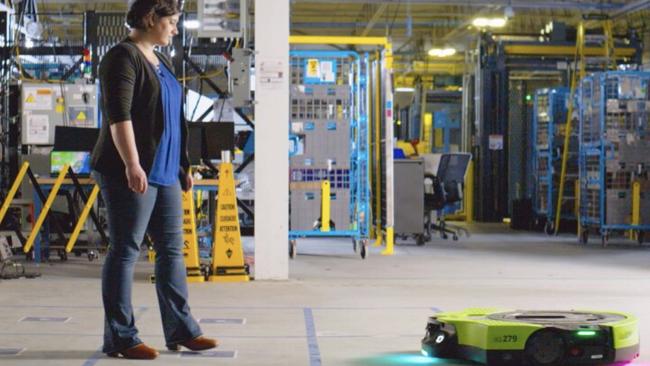What do sheepdogs and robots have in common? Ask Amazon
Looking at how a humble farm dog behaves has inspired Amazon to create a new robot that aims to speed up deliveries and improve safety in its warehouses.

Amazon is known for having a dog friendly office policy – now it is stretching its love of man’s best friend into its first “social robot” to assist workers across its warehouses and deliver packages faster.
The $US2.01 trillion ($2.98 trillion) company has become one of the biggest adopters of robotics, developing its own technology to deploy across its global network to keep up with booming online shopping demand while increasing staff safety.
Most of these robots look like vacuum cleaners – Amazon almost bought Roomba for $US1.7bn in mid-2022 – that bring shelving units full of stock to employees during fulfilment, rather than staff wandering around aisles to search for a particular item.
Amazon has been testing a bipedal robot dubbed “Digit” – as part of its partnership with Agility Robotics. But Mikell Taylor, the head of Amazon’s autonomous robotics program, said people shouldn’t expect to see fully-fledged humanoid-looking machines operating in its warehouses soon.
“The robot that I work on, Proteus, is very much not a human form factor. It’s got eyes, it’s got a little bit of a personality, a little bit of a character, but we very explicitly didn’t want people to think of it as a person or as a human,” said Ms Taylor, who was in Sydney this month.
“Part of that reasoning – in discussions with our user experience and industrial design teams early on – was that when something looks like a human, you tend to ascribe to it the capabilities of the human and therefore also the responsibilities of a human.”
Rather, Ms Taylor has taken inspiration elsewhere to develop Amazon’s “first social robot” called Proteus that fits more in the company’s pedigree.

Amazon was one of the first big employers to allow staff to bring dogs to work after a Welsh corgi, named Rufus, effectively became founder Jeff Bezos’s good luck charm in the 1990s.
Rufus became a feature at the company’s early website launches, where his owners hovered his paw over a keyboard and dropped it to flip the site. By 1998, Amazon allowed all dogs as part of its lease at Beacon Hill’s Pac Med building in Seattle, and silhouettes of corgis are featured on signs across the company’s current headquarters, indicating where dogs are allowed and not allowed to go.
And it’s a working dog mindset that Ms Taylor is imbuing into Amazon’s robotics program.
“If it looks sort of like an animal or reminds me more of like a pet or a farm animal, you have very different expectations of it. And given the state of robotics right now, as we’re introducing these into people’s workplaces, we think that kind of animal analog is maybe better in terms of the expectation management and how we want people to be around it,” Ms Taylor said.
“And I think that’s been fairly successful so far with Proteus. Like a border collie, right? A working dog, you may be a bit forgiving of it when it messes up now and again. You know, it doesn’t fully understand, but it’s still doing a lot of really useful work for you.”
Amazon unveiled Proteus, its first fully autonomous goods-moving robot – two years ago, and is planning to launch it across more of its site soon. Proteus, which looks more like a Roomba vacuum than a humanoid – has two eyes and light that looks like a mouth in an effort to inject some personality. But it is a highly capable machine that is designed to lift and move large carts, weighing up to 362 kilograms, while navigating through areas full of humans.
It is largely a reflection of postmodernist culture and the high expectations from consumers.
“Everyone is demanding more choice faster,” Ms Taylor said.
“Whether you’re ordering from Amazon or you’re ordering from another retailer, or you’re going to a brick and mortar store looking for something, you want more options, and you want it as fast as you possibly can.
“And I think to keep up with that demand to your point, rather than having more people moving faster and in potentially unsafe ways, having robots to help them will help us meet that demand from consumers and get people the kind of shopping experience that they want.”
Ms Taylor was in Australia to understand how Amazon could launch Proteus across its local fulfilment centres.
“One of the things that we want to make sure we get right before we come here is that sort of character that personality of Proteus, is very culturally dependent. Right now, we’ve been really developing for the North American market. The way that Proteus makes eye contact, the sounds that it makes, the light patterns and colours that it uses to convey, you know, whether it’s intent or its status is, those may have very different meanings in other countries and regions.
“Not to mention that it obeys rules of the road. It drives on the right and passes on the left, and they’ll be opposite here and in the UK and in Japan. So we have some sort of cultural context work to do that is unique to Proteus, because it is our first kind of social robot that has to obey these cultural norms that people have.”






To join the conversation, please log in. Don't have an account? Register
Join the conversation, you are commenting as Logout